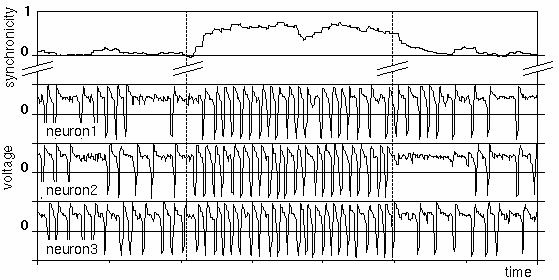Synchronous Neural Activity in the Visual Cortex
Synchronous Neural Activity in the Visual Cortex
Introduction
Advances in information technologies have often been inspired by studies of cognitive processes in the brain. In order to obtain optimal algorithms for the processing of visual information, we want to achieve an understanding of the basic principles guiding biological visual processing. Von der Malsburg had earlier suggested that achieving firing correlation might allow the brain to link stimuli from the same visual object. Recently, experiments by Singer and others have revealed stimulus-dependent firing correlation between neurons of the visual cortex. Our aim was, thus, to understand the role of firing correlations in the visual cortex. This research has been conducted by Christian Kurrer, a graduate student in the Physics Department, who has been a member in our group for five years and has recently finished his dissertation research.
Description
This research started with simulations of large arrays of coupled neurons in order to investigate under which conditions synchronous firing activity is obtained. Our results showed that the occurrence of firing synchrony can be triggered by changes in the excitability of the neurons in the visual cortex. Investigations of this transition from asynchronous to synchronous firing showed that the onset of firing synchrony is always accompanied by a marked increase of the firing frequency. Therefore, we have proposed that achieving firing synchrony between neurons processing the same object might be a mechanism to increase the contrast between the object and its background. The notion that excitable neurons can synchronize their firing activity rapidly is important for understanding its role in visual processing, especially in such tasks as visual tracking. Visual tracking requires fast responses to constantly changing visual inputs.
The figure shows a typical simulation of neuronal firing activity. The three lower traces show the trans-membrane voltages of three different biological neurons, modeled by the Bonhoeffer-van der Pol (BvP) model. The neurons initially fire at a moderate frequency. At about one third through the simulation, the excitability of the neurons is increased. The neurons thereupon start to fire synchronously. The uppermost trace shows a measure for the firing correlation among the neurons. It shows that the neurons achieve almost maximal synchrony within two firing periods. At about two thirds through the simulation, the excitability is lowered back to its original value. The neurons rapidly loose their firing correlation. During the period of higher excitability, the neurons also fire at a higher frequency.

Voltage traces of three interacting neurons (lower three curves). In the middle section, the excitability of the neurons has been increased, leading to firing synchronicity (top curve).
We have recently generalized these results by studying a more abstract model of neuronal dynamics which yielded the same effects. We were thus able to establish that the effects observed in simulations of BvP neurons are due to the fact that a BvP neuron behaves as an excitable system. This general result implies that firing correlation does not depend on the specific characteristics of neurons in the visual cortex and, therefore, plays a role in a variety of related recognition and response tasks. As an example, the recognition phase in the olfactory cortex is also characterized by oscillatory firing activity. Furthermore, this result also allows us to simulate the activity of biological neurons with much simpler excitable dynamical systems, such as active rotators. The use of these simplified neuron models will lead to a considerable computational speedup. This will allow one to use the concept of synchronous firing activity for biologically realistic, real-time processing of visual information, such as is required for visuo-motor control tasks.



